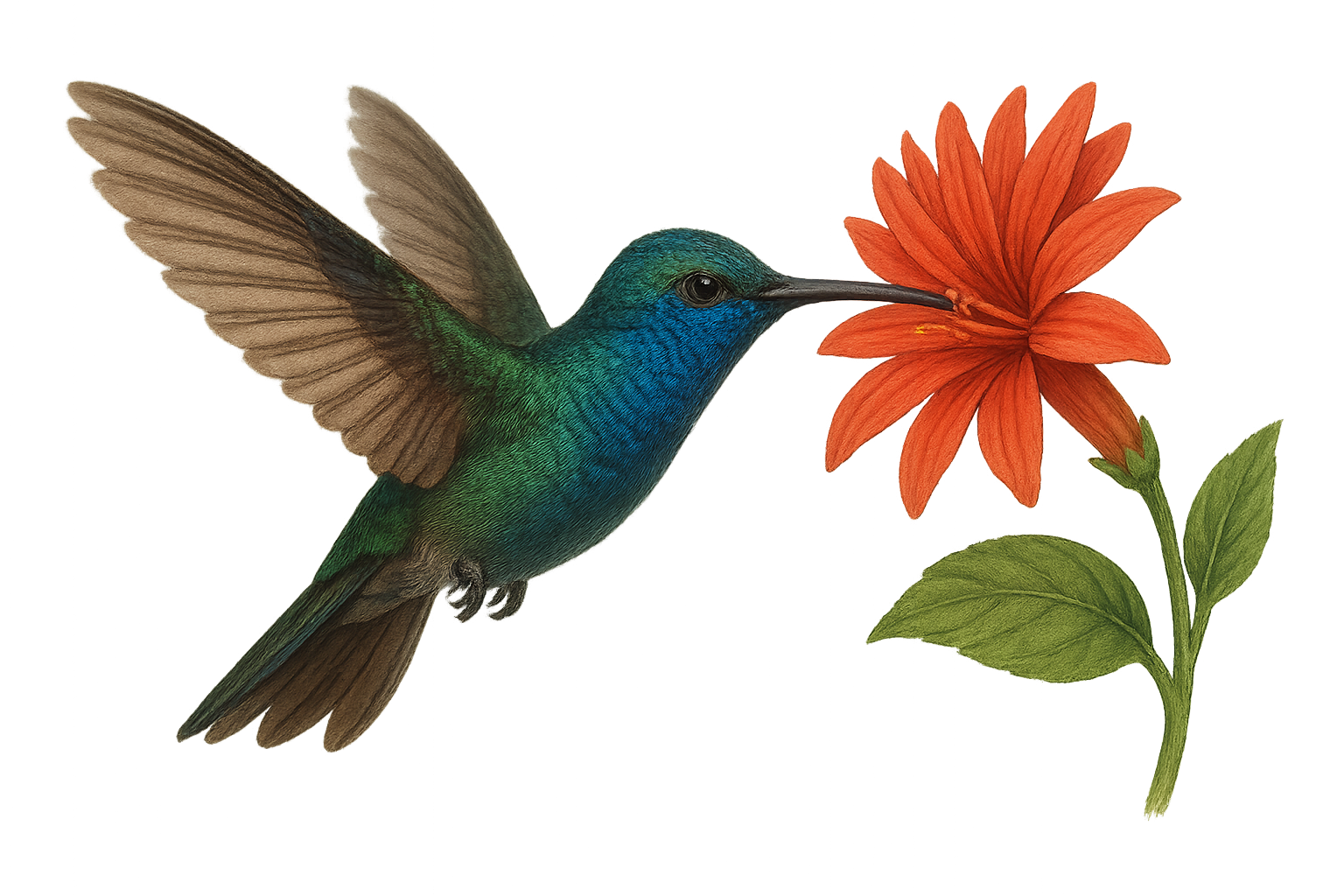Curaçao’s Hummingbird
Nature’s Aerial Acrobat
Curaçao, the Dutch Caribbean island famed for its colorful architecture, azure waters, and desert-like terrain, is also home to one of nature’s most remarkable creatures: the hummingbird. Often referred to as “living jewels,” hummingbirds on the island captivate with their iridescent plumage, rapid wingbeats, and fearless demeanor.
But who exactly are these tiny dynamos? Let’s take a deep dive into the species, behavior, habitats, and cultural significance of Curaçao’s hummingbirds.
The Ruby-Topaz Hummingbird (Chrysolampis mosquitus)
The most iconic and widespread hummingbird found on Curaçao is the Ruby-Topaz Hummingbird. Locally known as kolibrí, this species is a true Caribbean native, present throughout the ABC islands (Aruba, Bonaire, and Curaçao).
Size: 8–9 cm (3–3.5 inches)
Males: Metallic ruby-red throat and crown with fiery golden underparts that glow like hot coals in the right light.
Females: More subdued olive-green and white plumage with hints of bronze.
Wings: Narrow, dark, and beating up to 80 times per second.
Their coloration can shift dramatically depending on the light, making them appear like living sparks hovering in midair.
Chrysolampis mosquitus
Habitat and Diet
Ruby-Topaz Hummingbirds are commonly found in:
Dry scrublands
Cactus-laden hillsides
Gardens and flowering courtyards
Coastal thorny brush
These birds are nectarivores, feeding primarily on the sugary nectar of native and ornamental plants such as:
Aloe vera
Flamboyant tree (Royal Poinciana)
Cacti blooms
Bougainvillea
They supplement their diets with small insects and spiders, especially during breeding season when protein is essential.
Fast, Fierce, and Fearless
Despite their tiny size, hummingbirds are notoriously territorial. Male Ruby-Topaz hummingbirds are known to chase away intruders—including much larger birds or even humans—from their feeding zones.
Their aerial displays include:
Rapid zig-zags and dive-bombing maneuvers
Hovering in place to feed with incredible precision
Flashing their vibrant gorgets (throat feathers) as warning or courtship displays
They are also known to return to the same feeding spots and nesting areas every season, showcasing their strong site fidelity.
Breeding and Nesting
Curaçao’s hummingbirds typically breed between March and July, coinciding with the island’s flowering peak. Females build tiny cup-shaped nests using plant fibers, spider silk, and lichen—camouflaged and usually placed on thin branches.
Clutch size: 2 eggs
Incubation: ~15 days
Fledging: ~20–22 days after hatching
Nests are marvels of micro-architecture and are reused or rebuilt season after season.
As prolific pollinators, hummingbirds are crucial to Curaçao’s natural ecosystem. Their long bills and specialized tongues allow them to reach into deep flowers, transferring pollen from bloom to bloom. In a landscape with limited rainfall and rugged terrain, their role in sustaining native plant life is invaluable.
They contribute directly to the health of:
Cactus populations (which store water)
Ornamental flora in urban gardens
Wild native blossoms in the dry forest areas
Hummingbirds in Curaçaoan Culture
While not as prominently featured as other symbols, the hummingbird is increasingly seen as a spiritual and ecological icon on the island:
Symbol of resilience: Despite harsh climates, the hummingbird thrives—much like the people of Curaçao.
Art and craft: Local artisans often depict hummingbirds in jewelry, ceramics, and mural art.
Eco-tourism appeal: Birdwatchers and nature lovers visit specifically to observe these birds in their natural environment.
Where to Spot Them
Of course the Cliff Villa Peninsular is the ideal place. Other places are:
Christoffel National Park – Particularly early in the morning
Shete Boka National Park – Near flowering shrubs on the inland trails
Private gardens and guesthouses – Many install sugar-water feeders
Landhuis Knip and other historical estates – Known for lush landscapes
Pro tip: Wear red or orange and stand near flowers—hummingbirds are curious and often approach humans!
The Ruby-Topaz Hummingbird is currently listed as Least Concern on the IUCN Red List. However, local threats include:
Habitat loss from development
Pesticide use affecting insect populations
Climate change impacting flowering cycles
Protecting local flora and educating visitors helps ensure these dazzling birds remain part of Curaçao’s skies for generations to come.
How You Can Help
Plant native flowers like hibiscus and aloe.
Avoid pesticides in home gardens.
Support eco-tourism initiatives and wildlife preservation groups.
Educate others about the island’s unique biodiversity.

